Unified Payments Interface (UPI) transactions grew 58 per cent by volume to 9.96 billion in July 2023, according to the National Payments Corporation of India (NPCI).
In terms of rupee, the transaction amount grew from Rs 10.63 lakh crore in July 2022 to Rs 15.34 lakh crore in July 2023, up by 44 per cent, according to NPCI.
Data further shows the growing penetration and adoption of UPI across India. Since its introduction in 2016, UPI has now become a preferred mode for financial transactions, particularly for smaller amounts. The participating banks in the real-time payment system have also grown from 21 in 2016 to over 380 in December 2022 and 458 as of June 2023.
One of the major reasons for the popularity of UPI is its ease of use. It has grown manifold since its launch and has also surpassed the adoption rate of other modes of financial transactions, such as credit cards, debit cards, national electronic funds transfer (NEFT), and real-time gross settlement (RTGS).
According to the 2022-23 economic survey, UPI accounted for 17 per cent of the total 3,100 crore digital transactions in FY 2019, which increased to 52 per cent of the total 8,840 crore financial digital transactions in FY 2022.
The survey envisioned that ‘UPI will help accelerate the process of financial inclusion and digital adoption’, and also help in catering to the larger population.
UPI also offers the advantage of providing access to multiple bank accounts in a single mobile application with various banking features and faster fund routing.
Advantages Of UPI
Here are some of the advantages of UPI
There is no charge for using UPI and making transactions through it. On the other hand, for using a debit card, you have to pay an annual maintenance charge. For credit cards, there may be an annual fee. Besides, credit cards charge interest and penalty for late repayment.
You can use UPI for transactions round the clock and across the year. The amount transfer is instantaneous, unlike in case of NEFT or RTGS, which takes some time for the transfer to complete. You also don’t need to carry your card or need the bank details of the receiver for transferring money.
UPI offers one single window for different transactions with a single click, which makes it easy to do different transactions, including routine payments in much less time.
Disadvantages of UPI
UPI also has some disadvantages. Here are they:
As it is completely digital, it is not immune to technical glitches.
Also, in case of a wrong transfer, one will have to follow up with the banks or the app provider if the recipient’s bank is different from the sender’s.
This could be tedious for senior citizens, who are yet to catch up with the technology and are still trying to learn it. As such, seniors may still prefer to transact through manual modes, such as cash or cheques.
Instances of online fraud could also be scary for those not keen to use technology-driven modes.
Precautions To Maintain
NPCI, the nodal body behind launching UPI has said that one should be careful while doing any transaction online and follow the necessary precautions.
Incidentally, these precautions not only relate to UPI, but is equally valid for other kinds of digital financial transactions, as well.
It suggests not sharing your UPI PIN. Also, one should not share the UPI ID, debit card details, and OTP.
Also, one should never send SMS to any unknown number with unknown codes, and also not send money to unknown sources.
Lastly, one should never post details of one’s financial transactions on social media.














